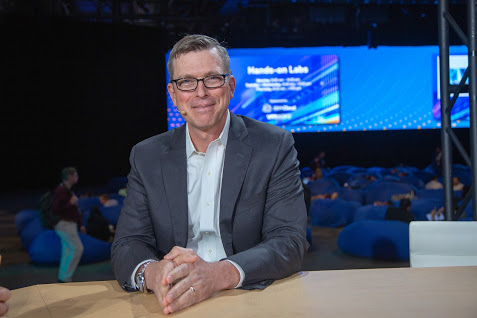 INFRA
INFRA
 INFRA
INFRA
 INFRA
INFRA
Historically, networking has been a complex system of hardware meets software. Cloud computing is now changing the way the enterprise looks at networks.
“We’ve seen a massive wave of adoption and moving to this open, disaggregated and software-defined network,” said Drew Schulke (pictured), vice president of networking at Dell EMC. “We’re going to be the company that’s going to have the conversation around a modern network, that’s going to enable you to be software-defined and live in that multicloud world.”
Dell Technologies Inc. is moving to a software-defined network that meets the challenges of today’s data centers, which deal with massive volumes of data traffic, device proliferation, and multicloud environments. Dell EMC’s PowerSwitch brand is simplifying the way companies approach networking that disaggregates network software from hardware to give customers more choice, flexibility and innovation, according to Schulke.
Schulke spoke with Stu Miniman (@stu) and Dave Vellante (@dvellante), co-hosts of theCUBE, SiliconANGLE Media’s mobile livestreaming studio, during the Dell Technologies World event in Las Vegas. They discussed automating the network for hybrid cloud with open networking and what conversations Schulke’s having with customers bringing their networks into the new age (see the full interview with transcript here). (* Disclosure below.)
[Editor’s note: The following answers have been condensed for clarity.]
Vellante: Talk about trends in networking over the past several years. Obviously, cloud is changing the way people are looking at networks. What’s going on?
Schulke: Rewind the clock back five years ago because that’s when I think we had this seminal moment in networking where we took an unprecedented step to say we wanted to disaggregate the networking stack — we want the hardware discussion and the software discussion around networking to be distinct. It wasn’t novel for the network at the time, but for the rest of the IT industry, if you think about the way storage and servers and virtualization had evolved, we were really playing catch-up from a networking perspective. That really opened up a whole new era of networking for us, in terms of what we were doing as a networking vendor.
You also look at what some of the big hyperscale companies were trying to do with their own networks, and there was this great synergy to put together this cloud-computing-era networking stack that was fundamentally different than what we’ve seen for the past 20 years.
Miniman: Explain how, while you’re disaggregating, this is going to be simpler for customers and operationally it’s something that they shouldn’t have to touch too much.
Schulke: By disaggregating, we let the software guys do what the software guys do, which is software. Software’s a powerful tool when it comes to the network. That was never really fully tapped until we opened up the switch and allowed it to be agnostic to the software that was running on top of it.
Our mission in working with companies like Big Switch is to bring a level of simplicity to a piece of the data center that has been thriving on complexity, where people got paid by understanding how complex things were, and it really doesn’t have to be that way. Software can be powerful, software can make lives easier, software can be an integral part of that IT transformation story, and networking is no different when it comes to that.
Vellante: You can’t talk with VMware executives without hearing about NSX. So what do you do with regard of NSX and NSX integration?
Schulke: The great story that we have about NSX in terms of what it’s expecting of the physical network that’s actually powering the network (the underlay), is they want it to be fabric based. They want it to be good at transport and easy to manage. So a lot of the work that we’ve been trying to do with them is figuring how we present that network in an NSX environment, so that that physical and virtual network come together in a seamless way. That’s an area that we’re spending a lot of time on.
Miniman: When we’ve looked at multicloud, SD-WAN is one of those areas that customers said, “This is a real enabler. I can’t really do multicloud. I can have a bunch of pieces, but if I want to tie it together, SD-WAN’s enabled me.” Can you explain why that is?
Schulke: At the end of the day, you’re sitting on your endpoint device, and think about the traffic padding that you’re generating as an employee. Some of that traffic is going to public cloud A, some of it’s going to public cloud B, and some of it’s going to a centralized data center. These traffic patterns are becoming more complex. They’re carrying more and more traffic as we crank up the bandwidth in terms of what we’re trying to support. How do our customers bring order to that? If you don’t have a software-defined approach where you can bring some level of centralization of policy and end-to-end visibility of all those endpoints, it’s going to become unruly, which is what it’s become for a great many customers.
So, it’s very rare that I come across a customer that doesn’t want to have an SD-WAN conversation to your point, because the pain points are there and traffic continues to grow. The multicloud story means I have to direct it to several different clouds, including my own, including the others, and I have to have an effective way to go do that.
Watch the complete video interview below, and be sure to check out more of SiliconANGLE’s and theCUBE’s coverage of the Dell Technologies World 2019 event.(* Disclosure: Dell Technologies Inc. sponsored this segment of theCUBE. Neither Dell nor other sponsors have editorial control over content on theCUBE or SiliconANGLE.)
THANK YOU